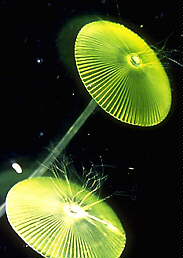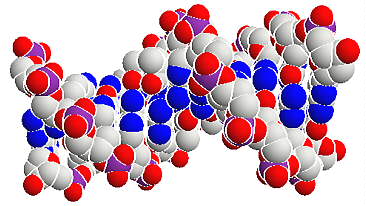
The research that began with the acceptance of the chromosome
theory of inheritance led to a new discipline: biochemical
genetics. One of its main contributions is the one
gene : one protein hypothesis that proved to be extremely
helpful.
model organisms. The new organisms found, bacteria and viruses
were the starting point for a new research area, molecular
genetics. It led to exponentially growing insights into the
structure and effects of genes, but one of its main discoveries
was the finding that the basic mechanisms of the storage and
expression of genetic information as well as the chief pathways of
metabolism are the same in micro-organisms, animals, and
plants.
Simultaneously, other researchers were interested in the nature of genes and in the details of the transfer of genetic information. First, it was demonstrated that no other class of molecules than DNA has the ability to transfer properties from an intact line of pneumococci to a defect one, then, the three-dimensional structure of the DNA was elucidated. These findings led subsequently to answers to the question of the doubling of the DNA. It was found out that the chromatid doubling occurs in a semiconservative way, i.e. that the DNA double strand is separated and that both single strands serve as a matrix for the newly generated double strands.
Around the mid-thirties, the questions posed at the beginning of
the century had largely been answered, no more doubts existed
concerning the chromosome theory. This does not mean that the
reviewed methods and problems should not be dealt with any more -
exactly the opposite is the case. The research into cultivation
renders the production and selection of new varieties necessary. Just
because cultivated plants grow optimally only under certain
environmental and growing conditions, it is important to cultivate
varieties that can also be grown in other parts of the world,
especially in third world countries. Here, the number of still
existing problems outgrows that of solved ones.
The study of the evolving problems of evolution research is not
finished yet, too. Up till now, it has mainly been worked with plants
of temperate and cold climates. But how about tropical plants?
Independent of these problems, the following questions arose:
![]() how
does a gene work?
how
does a gene work?
![]() what
exactly is a gene?
what
exactly is a gene?
![]() what
is genetic information and how and where is it doubled?
what
is genetic information and how and where is it doubled?
![]() how
is genetic information realized?
how
is genetic information realized?
![]() how
do genes control the development of an organism?
how
do genes control the development of an organism?
It took only a few decades to obtain satisfactory answers. New ideas, the use of new methods and the combination of different disciplines of biology, chemistry and physics were decisive. The information- and system theory, developed during the 1940s, proved to be an important guideline.
It had been noticed rather early that the phenotype
is the result of a complex series of reactions between gene products,
intern and extern factors.
But to get to know how, for example, a certain red flower colour
was generated, it was not enough any more to perform crossings and to
protocol the resulting phenotypes. Much more so, it was necessary to
isolate the colour and to analyze it chemically.
In the middle of the 1930s, chemistry, especially biochemistry was
changing rapidly. The classic old methods were increasingly replaced
by physico-chemical techniques, like radioisotopes, spectroscopy and
chromatography with all its variations. Especially the latter allowed
the analysis of mixed substances and to prove the existence of
substances in concentrations far below the limits of conventional
methods.
M.WHELDALE found already in 1907 that the flower colour of
Antirrhinum majus is
caused by two groups of colours that are dissolved in the cells: the
yellow or yellowish flavones and the red or reddish anthocyans. He
assumed that similar substances led to different colours and that the
presence of both caused a mixed colour. The presence of a certain
colour has not to be regarded as a yes or no decision, since the
different concentrations of the respective components can lead to a
whole range of different phenotypes. The resolution of their chemical
structures was performed some decades later when it also became clear
that genetic changes and changes in the chemical composition of the
colours were related.
An important step was made by A. KÜHN with his studies of the synthesis of the eye colours of the moth Ephestia kühniella. They are derivatives of the amino acid tryptophane; several genes control the production of the colour. But the real breakthrough and consequently also the beginning of the so-called biochemical genetics was made by the Americans G. W. BEADLE and A. L. TATUM (Stanford University, Palo Alto/San Francisco) with their studies of the fungus Neurospora crassa. The mycelium of this fungus can be cultivated on a rather simple agar containing some salts and vitamins. Röntgen radiation leads to the generation of a number of mutants that cannot grow on this minimal media though it is possible to grow them after addition of a mixture of amino acids to the media. This observation allowed BEADLE and TATUM to vary the supply of nutriments in order to find the genetic defect. An example will illustrate the principle: a group of mutants needs the amino acid tryptophane as a supply to the minimal media. It was known as soon as the early 1940s that it is produced from the precursors anthranile acid, indole and serine.
The genetic analysis showed that several of the tryptophane
mutants (tryptophane auxotrophic mutants) grew also after addition of
one of the precursors. The results were collected in a scheme that
illustrates the biosynthetic pathway of tryptophane. Biochemists say
that each of the subsequent steps is performed by an enzyme
and that the genetic data link a gene and an enzyme. This link
says:
This statement proved to be one of the most useful hypothesis of
the last decades. We will often refer to it and we will learn that it
has been altered and restricted by newer results though its core
remains unchanged.
The eminent advantage of the model organism Neurospora crassa compared to all model organism mentioned up till now (including Drosophila melanogaster) is that the mutants can be kept alive by manipulation of the media. This allowed the elucidation of the defect's nature. On the other hand, the genetic effects were studied looking mainly into the production of single amino acids.
An unbiased observer such as the geneticists of the first half of
the 20th century did think the differences in the flower
colour to be easier analyzed. But for a chemist, the analysis of the
amino acid synthesis suggests itself since amino
acids are chemically much more simple than colours.
After marking the outlines, it was looked for simpler model
organisms. Bacteria and viruses were
obviously suitable. What followed is collectively termed molecular
genetics. The number of insights into structure and effects of
genes grew exponentially. During the 1950s, 1960s, and 1970s, most of
the geneticists worked with micro-organisms; plants were hardly
worked with at all. Our knowledge about the molecular basis of their
genomes was at first founded on extrapolations of the results gained
with micro-organisms. But these speculations did not last very long
since most of them were soon verified in plants.
The most important result achieved was that the chief mechanisms of the storage and expression of genetic information as well as the main pathways of metabolism are the same in micro-organisms, animals and plants. They seem to have been optimized before their lines of development parted.
These questions were answered in two steps. It has been mentioned
before that O. T. AVERY, C. M. McLEOD and M. McCARTY (1943)
demonstrated that DNA has the ability to
transfer properties from an intact line of pneumococci to a defect
one thereby repairing the defect completely. No other type of
molecule is able to perform the same task.
The second part of the answer was given by physicists. The
precondition was the development of structure analysis by
Röntgen radiation to elucidate the three-dimensional arrangement
of atoms within a molecule. The result is well-known: in 1953, J. D.
WATSON and F. H. C. CRICK presented the DNA
double helix - (interactive file) named after them.

But how and when does the DNA doubled in the cell? Here again two answers exist:
Every cell that is able to divide passes through a cell
cycle whose interphase state is organized into G1-,
S- and G2-phase. During S-phase (synthesis), the
genetic material is doubled.
During G2-phase, the cell contains thus twice the amount of DNA as during G1-phase. It can be detected cytohistochemically by use of a DNA-specific dye (Feulgen-reaction) and subsequent photometric measuring of the colour intensity that is directly linked to the amount of DNA. The nuclei of the G2-phase are bigger than those of the preceding phases since the number of chromatids has doubled. The relative length of the respective cell cycle phases is directly proportional to their frequency in a growing tissue. Cells that have lost their ability to divide or that have not divided for some time stay in a phase similar to the G1: the G0-phase.
The doubling of the chromatids occurs semiconservatively, i.e. the DNA double strand is taken apart into its two single strands. Each works as a matrix for a newly synthesized strand. The results are hybrid double strands. The mechanism was discovered by J. H. TAYLOR (Columbia University, New York) by autoradiography with 3H-labelled precursors of the DNA. He could show that the radioactivity is worked into both chromatids simultaneously. His specimen was Vicia faber. Today, radioactivity has been replaced by specific dyes allowing not only the observation of DNA synthesis but also the exchange of chromosomal fragments.
|
|